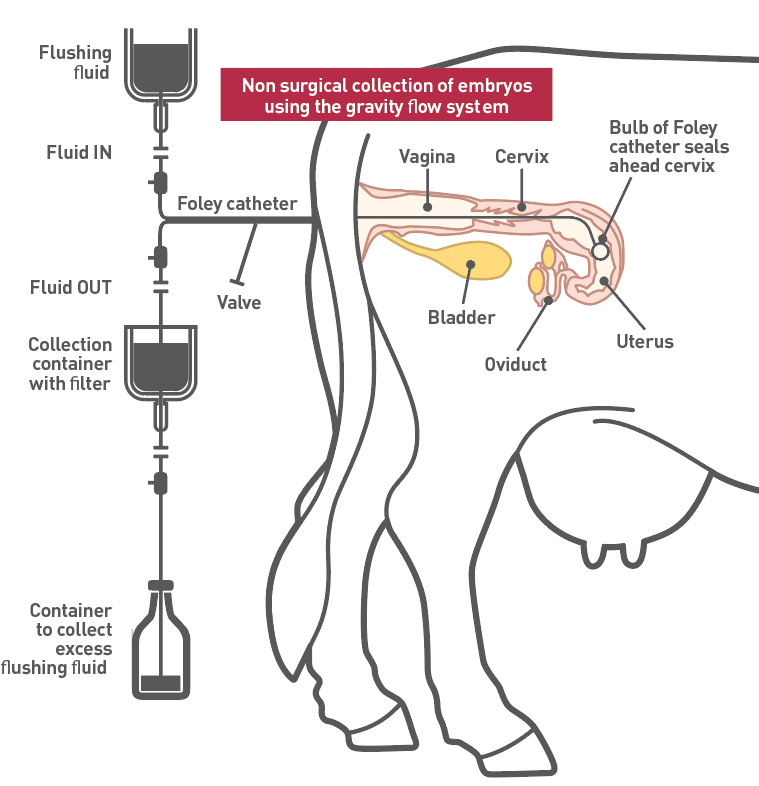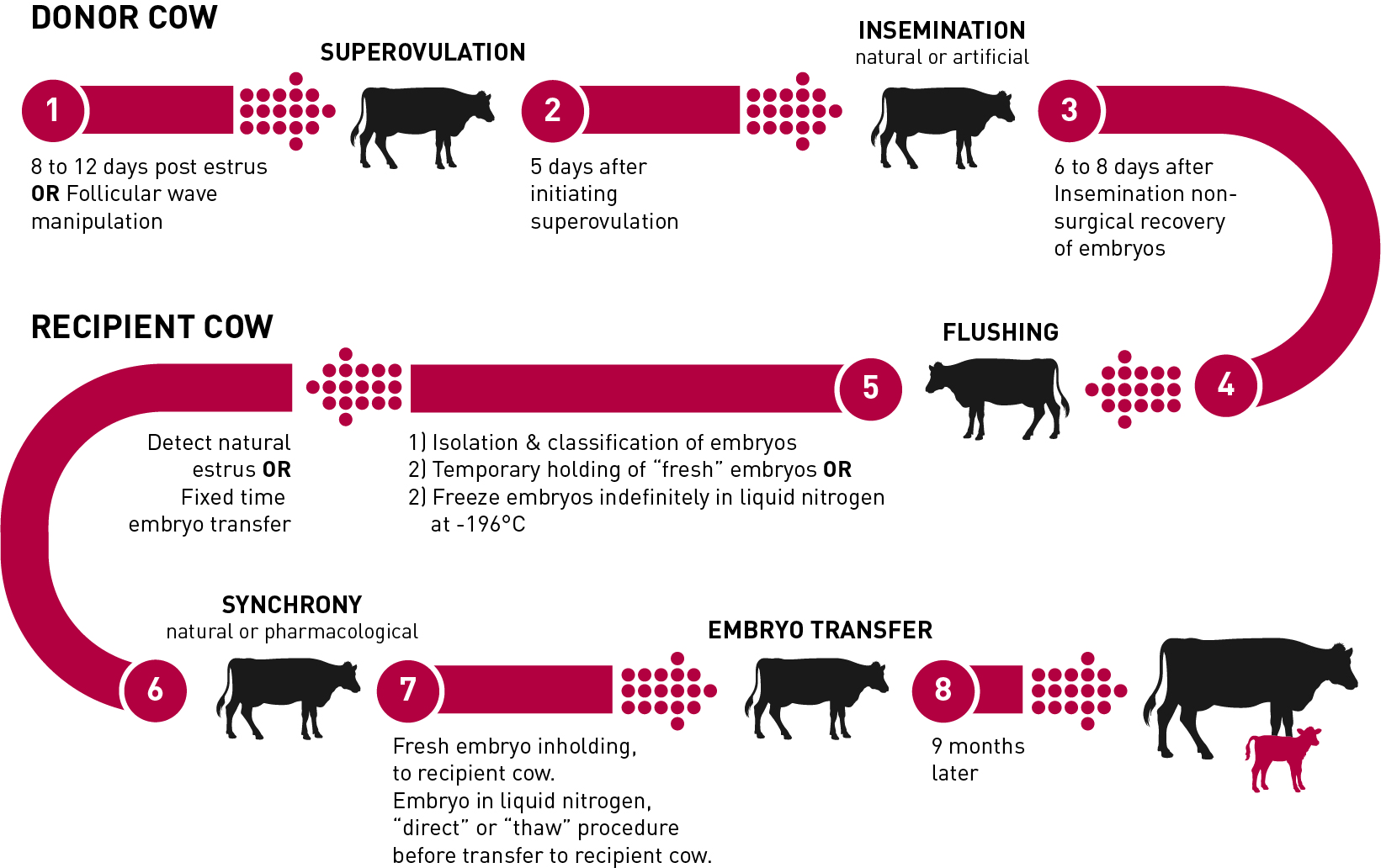
Gray Owl's Britta - A Popular Highland Genetics Donor Cow
The process of embryo transfer is a great way to optimize your best genetics. Cattle normally only have one calf a year. With embryo transfer, you can have multiple calves from the same sire and dam in a single year.
There are two types of Embryo Transfer. In Vivo (Conventional) and In Vitro (otherwise known as IVF). In this article we will be discussing the process of in vivo embryo transfer. If you would like to learn more about IVF, we have another article for that under our "Learn" tab.
The Donor:
The process starts with a donor cow. Or the selected female you would like to acquire embryo's from. Embryos are the genetic material from both sire and dam. Oocytes (egg) is the genetic material from the female. Therefore, before the embryo, you need oocytes/eggs. During the normal estrus cycle of a cow, it is typical for them to only release a single egg. For the process of embryo transfer, it is common practice to super-ovulate the donor, so they release multiple eggs.
Before the Embryo:
To Super-Ovulate, The donor is typically set up on a four-day regimen of twice-daily injections of follicle-stimulating hormone (FSH) to stimulate follicular growth (this is what eventually releases the eggs) On the third day of FSH treatments, the donor is also given an injection of prostaglandin. This brings the donor into estrus (or heat) within the next 24 to 48 hours.

One of Highland Genetics Donor Cows being flushed after superovulation
Embryo Retrieval:
Once the donor cow is in standing heat. (You can determine this by using a number of different methods. Heat detection patches are common). The donor is then bred by artificial insemination by the selected bull you wish to obtain the embryos from. It is important that the donor cow be inseminated within 24 hours of standing heat.

After the insemination, the embryos are left in the donor cow to mature for 7 days. After these 7 days it is then time to flush the embryos out of the donor cow. In this non surgical collection, an embryologist technician inserts a catheter intravaginally to collect the embryos. Mild sedatives can be used during this process. In the catheter is a saline solution, this enters the uterus and then exits into the collection container. This container has a filter designed to catch the embryos and separate them from the solution.

Evaluating the Embryos:
Once the flush is complete, the embryos are rinsed from the filter and evaluated under a microscope for their quality and stage of development. This is where grading occurs. Embryo's are assessed on a scale of #1-3 based on quality. 1 being the best, or most likely to successfully transfer and form into a calf. The embryos are then prepared either for fresh transfer into recipient cows or for freezing for transfer at a later time.

Recipient Cows:
"Recip" cows can be any breed or type. They will have zero genetic effect on the embryo and future calf. However, it is important that the recip cattle naturally have good mothering ability. As they will carry the calf through gestation and raise the calf through weaning. Angus breeds are common recipient cattle. Breeding age heifers and cows may be used. It is also important that the recip cattle be in breeding condition before the embryos are implanted. As recip cattle with low fertility and inadequate nutrition can result in the loss of an embryo.

A Highland calf with her black angus recip momma
If you do not plan on freezing embryo's for later use. The recip cow must be synchronized into the same heat cycle timeline as the donor cow. Therefore, when the donor cow is flushed on day 7. (7 days after standing heat) It is imperative for the greatest chance at a successful embryo to turn into a confirmed pregnancy that the ricip cows are also on day 7 of their cycle. This can be achieved through regular A.I synchronization protocols.

Results to Expect:
The amount of eggs released (and overall embryos created) is highly dependent on genetic and nutritional factors. Age can also have an effect. Fertility is also a highly genetic trait. Thus the importance of a good breeding program promoting the best females and making sure all nutritional requirements (such as vitamins and minerals) are met. Eggs created per superovulation and total embryos flushed can vary based on these factors. 2-12 embryos retrieved per flush is average.
With that being said, if your donor cow produces 10, #1 or #2 graded embryos. The likelihood for all 10 of those embryos of becoming viable pregnancies is minimal. The success rate is determined by a number of external and internal factors, several of which have already been listed above. In vivo embryo transfer generally has a 50-60% success rate.

BTTR Hibiscus and BTTR Willow, two embryo calves with the same sire and dam, born within a week of each other.
Sources:
Repro 360 https://repro360.com.au/reproductivetechnologies/et
https://www.merckvetmanual.com/management-and-nutrition/embryo-transfer-in-farm-animals/embryo-transfer-in-cattle
https://reprologix.com/services/bovine-division/conventional-embryo-transfer/
http://extension.msstate.edu/publications/publications/embryo-transfer-the-beef-herd#:~:text=Recipient%20Females,-In%20anticipation%20of&text=Time%20the%20start%20of%20the,for%20the%20establishment%20of%20pregnancy.
